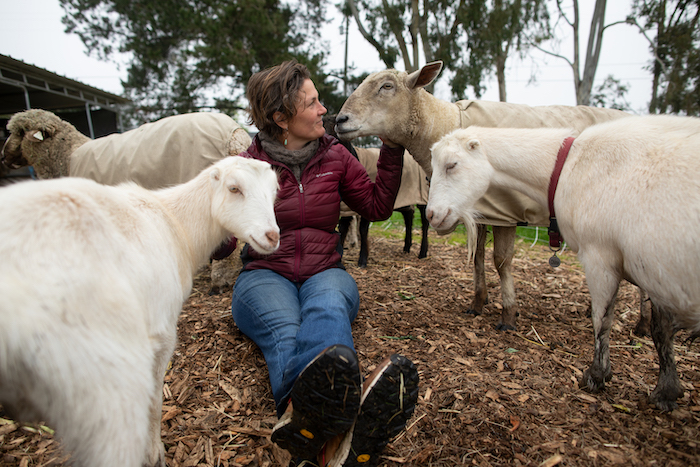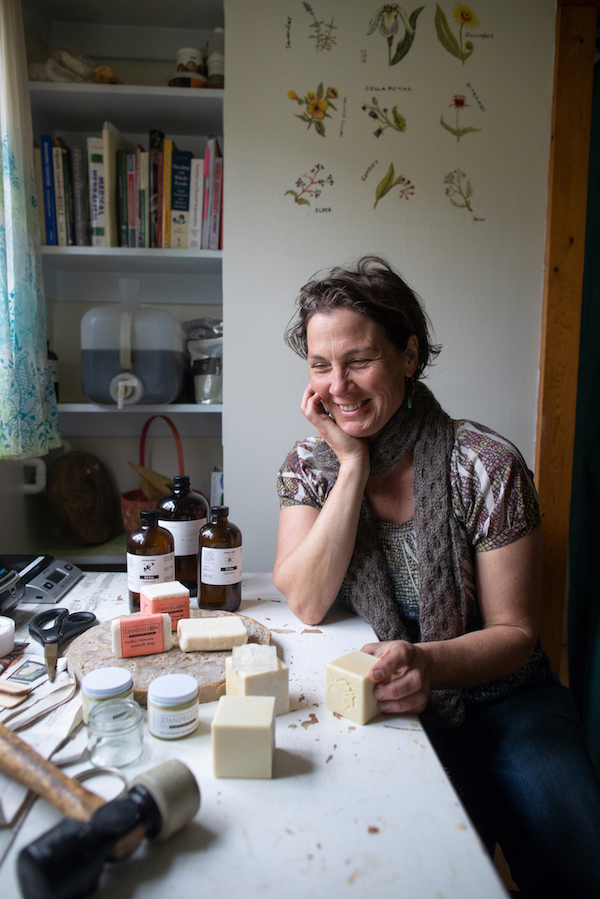Carbon Sequestration and Climate Beneficial farming at two-acre Wild Oat Hollow
It’s a blustery, rain-drenched late afternoon in January and I am sitting on hay inside an animal pen. Sarah Keiser of Wild Oat Hollow farm is tending to Zorro, her guard llama, with an IV filled with Thiamine. The seven-year-old animal contracted polio after becoming severely dehydrated.
An hour before, Keiser called me just after I arrived at the gate of her two-acre farm in Penngrove. “Do you want to be a real farmer today?” she said. “My llama is sick, and I need to stay here with him after the vet leaves. I’m up the hill at a neighbor’s property.”
I drive through the rural residential area to a suburban ranch-style house surrounded by muddy, green pastures. Here Keiser grazes her flock of sheep as part of her Penngrove Grazing Project. The project encompasses seven neighboring properties. Her face is ruddy from exertion in the inclement weather, and her blondish-brown hair is lanky and damp from the rain when she meets me in the driveway. We walk back into the field where the sheep graze in the gloom before crawling into the small, cozy pen Keiser constructed from scrap wood. Zorro hardly moves, his legs tucked gingerly beneath a long, cylindrical torso.
Keiser shuttles her animals up here by hoof from her farm a mile or so down the road, providing free sheep labor. It’s a practice she calls community-based rotational grazing, which has proven to be effective in wildfire fuel education and sequestering carbon in degraded soils. And it’s one of the many projects the vegetable farmer, fiber producer, and climate beneficial skin-care maker juggles, while parenting two children and working at Mentor Me in Petaluma.
Zorro guards the sheep from coyotes and neighborhood dogs. The fact that many of the sheep are about to give birth makes his presence even more essential. “If the Thiamine doesn’t work, we might have to put him down,” says the vet somberly, before leaving for another emergency.
Keiser and I settle in to talk as she holds the IV above Zorro’s head. Over the next two hours, our conversation spans everything from carbon sequestration to the economics of running a small family farm to the impact of Fibershed, a nonprofit started by Rebecca Burgess to promote local, climate beneficial fiber and textiles.
Later, as we say goodbye, a cold rain batters down, which doesn’t phase Keiser in the least. She speaks for a bit about the reality of death when you work in an interconnected way with animals.
“Death is a part of life on the farm,” she tells me.
Sadly, this was proven to be true when she emailed me the next morning to say that Zorro had passed away overnight.
Here, in her own words, Sarah Keiser talks about climate beneficial farming, the Penngrove Grazing Project, carbon farm plans, and her journey to small family farmer.
Becoming Wild Oat Hollow
“I grew up in Cedar Rapids, Iowa. I loved being out in the country. I started out riding horses when I was five years old. When I was 12, I saved up $500 to buy a horse. As an adult, I always wanted to have animals and I always wanted to have land. I moved to Santa Rosa in 2003. I came to visit a friend who was living in San Rafael and just fell in love. I met my husband here. We were living by the junior college in Santa Rosa, but we always wanted to get out to the country. I come from an environmentalist background, and I always wanted to manage and improve land, though at the time I didn’t have a grasp on rotational grazing and the benefits of animals. After we bought the place in Penngrove, we bought a couple of dairy goats—but they don’t keep the grass down. Then I found two Romney sheep on Craigslist. I learned how to shear from Jreed, the owner of the Mongrol Hoard. I blundered into Fibershed during my research and soon after took a spinning class and learned how to spin wool into yarn. After I met Marie Hoff, from Capella Grazing, my work went beyond just fiber into managed grazing.”
Carbon Farm Plan
Carbon farming means rotational grazing, compost application, riparian planting, hedgerow planting, and fencing livestock out of all riparian areas. A Carbon Farm Plan involves a write-up about the slope of your farm, soil types, and current and proposed farming methods. The Sonoma Resource Conservation District (RCD) then has to approve the plan to make it official.
Fibershed has been essential to getting my Carbon Farm Plan off the ground. They financially facilitated my grazing plan by hiring a consultant to help me create it. Small places have trouble bearing those burdens. My income is next to nothing, and to pay a consultant is really hard but necessary. I couldn’t have done it on my own. It’s a big, detailed, very specific kind of analysis.
There is a lot of help from RCDs and grants for the big ranches. The small people aren’t worth their time because their time is limited. But, Fibershed says if you get 20 10-acre places together, let’s think about what that means. You can do a lot on small land.
The RCD takes carbon soil samples every three years to check the carbon numbers for the land. Right now, I have really high carbon down three feet. We want to bring that carbon deep, deep to create more aeration and root systems down there and bring back those native perennials.
Economic Sustainability
If I’m going to be practicing sustainable land practices like carbon farming, I also need to make my system financially sustainable. If nothing else, it needs to support itself. I wanted to bring more revenue in. I started selling my wool raw so I wasn’t paying processing fees to a mill. My friend Peggy inspired me to show the fleeces at wool shows and they did really well. It’s the best way to bring revenue in. We won Supreme Grand Champion for my fine fiber. If you continue to win and build a reputation, people will seek out your fleeces. We also sell 100 percent grass-fed ram lambs for meat. And I started making goat milk soap. My friend came in and helped me create logos and packaging. And I teach classes on soap-making and other topics. The best way to sell my skincare product is direct to consumer. I want to have a really good sustainable product, but I feel very strongly that I have to make it financially available to most people. Otherwise I don’t see the sustainability in that either. Who can buy a $50 lotion? I want a product that people can buy, use, afford, and enjoy.
Climate Beneficial
Rebecca Burgess of Fibershed came up with the Climate Beneficial label. It’s a way of engaging the public and emphasizing the difference in these products. Climate beneficial is a way of farming where we are sequestrating carbon out of the atmosphere and into the soil. Climate beneficial means that all of my ingredients come from within my watershed. I’m not buying coconut oil; I’m not buying palm oil which I see in so many homemade soaps. Somebody said to me that palm oil is the new blood diamond. The production of it is horrible, and it’s in everything. They’re cutting down rainforests for it, getting rid of the orangutan habitat. I get the ingredients for my skincare locally from farms that are practicing sustainable methods. The olive oil is from Olive Leaf Hills. My hydrosols are from Herban Allies in Santa Rosa. The lard for the soap comes from Green Star Farm in Sebastopol. The lard is a byproduct that would normally be tossed out. Each pig will produce about 100 pounds of fat. This is a part of the animal that would be thrown away. Don’t we want every part of the animal to be used and not trashed?
Pasture Work
I am part of the Fibershed Pasture Cohort. At its heart, Fibershed is about community building, bringing people together, and facilitating restorative agriculture. It goes beyond fiber. In the cohort, we are learning the incredible difference managed grazing can make. Add some compost application on top of hedgerows and windbreaks and it’s a whole new place. I want to look around and see things improving. I want to see a diversity of plants, more perennials in my pastures, and better water absorption. We’ve decimated the majority of California grassland. When the Westerners arrived, they brought wheat, oat, and rye, and those grasses hedged out the natives. When you realize how much managed grasslands can sequester, it’s profound.



